Garrison Christian is a 20 year old undergraduate student at Portland State University. He is studying Urban Planning, with hopes of becoming a professional transportation planner.
As most of you already know, 82nd Avenue is going to be redesigned by the Portland Bureau of Transportation (PBOT) in the coming years. This is our chance to make it much better. In this post, I’ll share my ideas for how to achieve a safer, more equitable 82nd.
The street faces many challenges for safe transportation. 82nd is a high crash corridor, with multiple pedestrian deaths over the past 5 years, including one at SE Flavel Monday morning that marked the second one so far this year alone. Sidewalks along the corridor are particularly narrow, often with utility poles blocking the right-of-way. Many sidewalks lack ADA curb ramps, and 82nd is home to TriMet bus line 72, the highest ridership route in the entire Portland metro area.
PBOT is currently implementing ‘critical fixes’ along 82nd; these will be done in the next few years, addressing some, but not all of the concerns listed above. Following this, a comprehensive redesign will be done in the coming years, likely leading to an adjustment of how street space is allocated. The current street is five lanes wide, with one center left turn lane, flanked by two general purpose lanes on each side. In January, I attended Metro’s 82nd Avenue transit project advisory board meeting. This body is tasked with deciding how to best implement transit along the corridor. While bus-only lanes are under consideration, I have concerns with how they will be implemented.
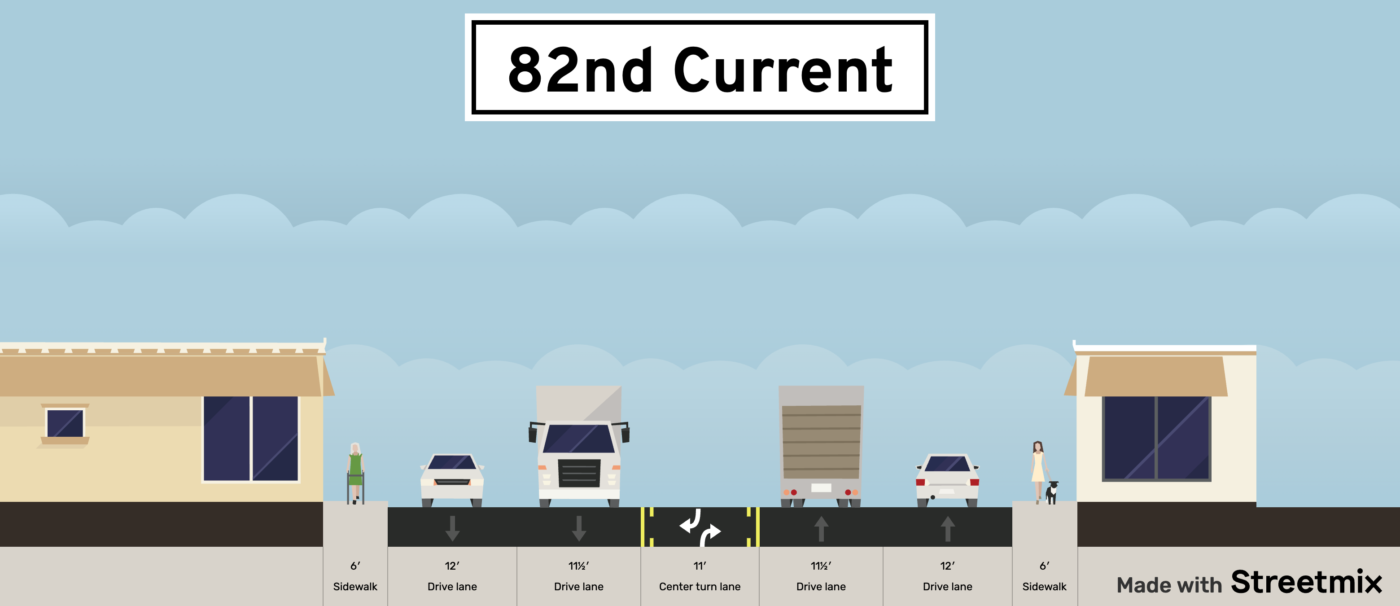
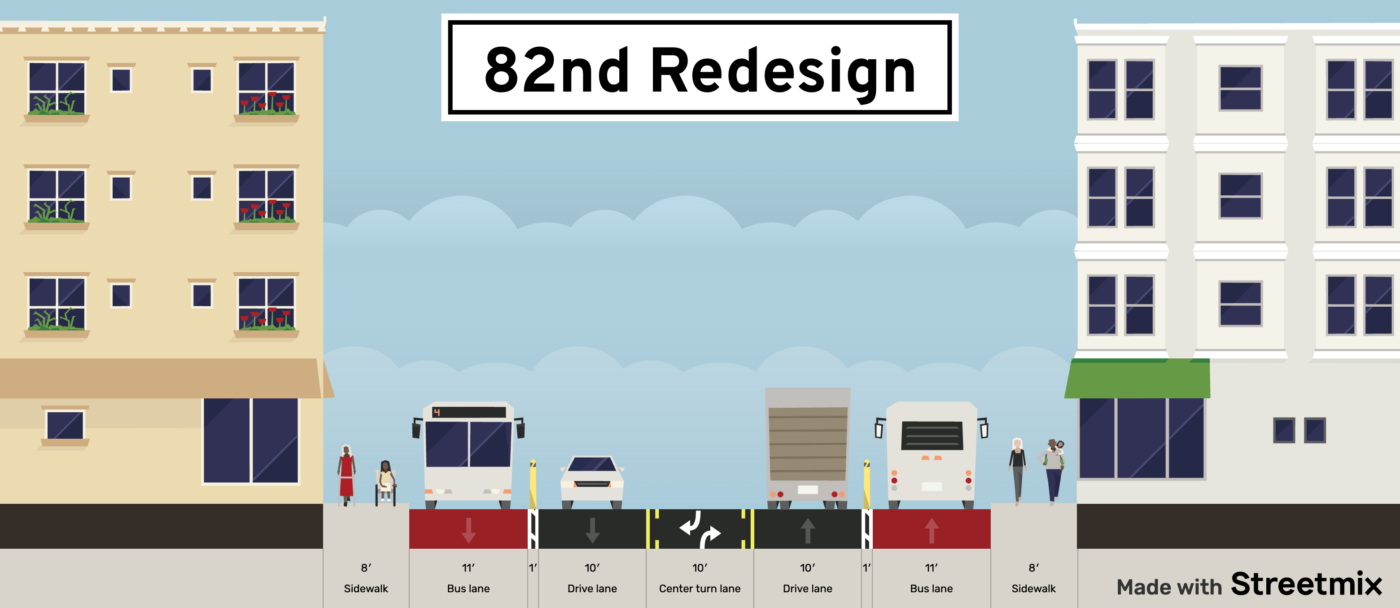
PBOT staff said they are likely to choose business access and transit (BAT) lanes for 82nd. While fine in a vacuum, BAT lanes need proper design and enforcement to best serve buses. Here are the changes I would like to see applied: First, bus lanes must be implemented on 82nd! I propose keeping the center turn lane, with one general purpose lane in each direction, and bus lanes against the curb. However, putting in bus lanes alone is not enough to improve bus service. Across town, our limited set of bus lanes are often clogged with cars illegally using the lane, which slows down buses. This is due to poor design and lack of enforcement.
Design measures such as a physical barrier should be used along 82nd to keep cars from driving in the bus lanes. Other cities have used Jersey barriers, concrete curbs, or even flex posts as barriers. An issue to contend with is driveway access for the many businesses along 82nd. The barriers between bus and general purpose lanes can have gaps to allow for turns into driveways. If planners refuse to use physical barriers, automated camera enforcement is another option. Cameras can be deployed to fine those who drive in the bus lane, with an exception given to cars turning to enter/exit the street.
Bus riders deserve to not be inhibited by cars clogging up the bus lane, and well executed design can prevent this conflict.

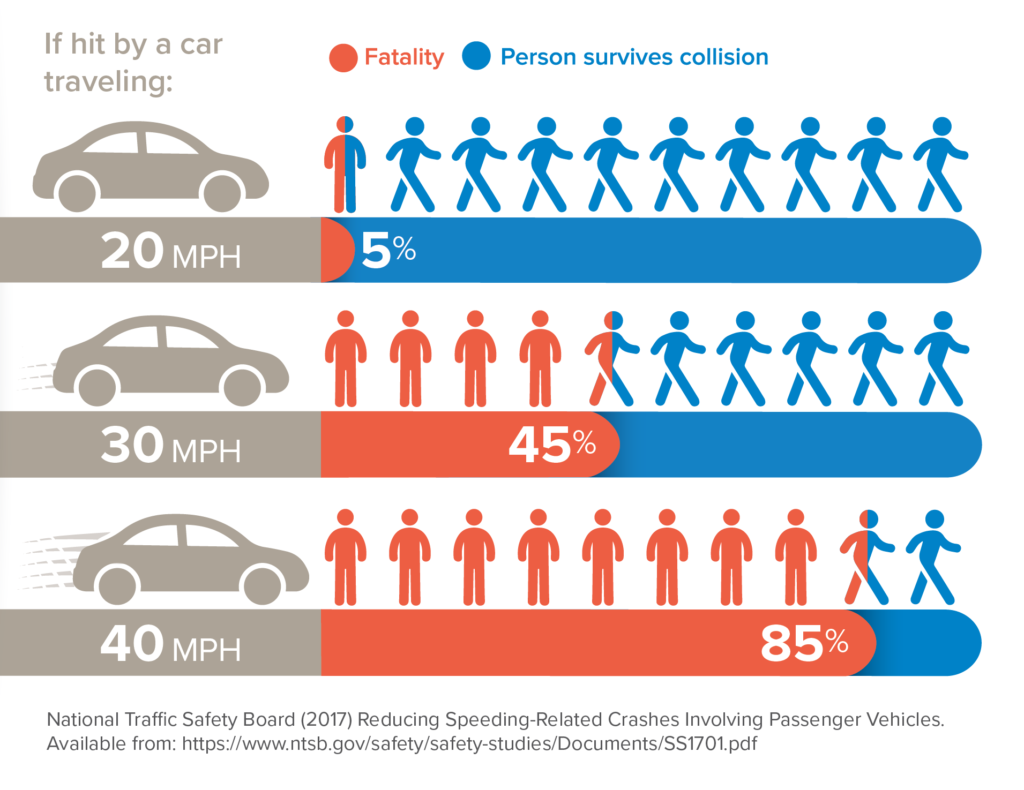
As for pedestrian safety, there are many design treatments we can use to improve 82nd. First off, sidewalks should be made wide, to accommodate foot traffic, as well as those with mobility devices. A minimum standard for sidewalks is six feet, but I propose 8-10 ft sidewalks, which allow for greater separation from traffic, and less crowding. Raised crosswalks are also a great tool to improve pedestrian safety. While having a posted speed limit of 30 mph, the wide lanes of 82nd allow for car speed of 40 mph or faster. Collisions between cars and pedestrians at this speed almost always leads to death of the pedestrian. Raised crosswalks force cars to slow down and this reduced speed gives drivers more time to react, drastically lowering the chances of death if a collision occurs.
The posted speed limit on 82nd should be 25 mph. Measures we can put in place to enforce this behavior through design including 10-foot lanes. 10-foot lanes lead to more cautious driving. By comparison, many streets use 11-13 foot lanes, which have been proven to lead to faster, unsafe speeds. Raised crosswalks are especially useful to prevent vehicles from turning at high rates of speed. A turn taken at 15 mph is much safer than one at 30 — for both the driver and pedestrian.
In conclusion, we have a once-in-a-generation opportunity to change 82nd for the better. We can achieve better safety along the corridor for all road users, reduce our emissions by improving bus service, and create a more hospitable environment for pedestrians. As the public participation process starts for this project, be sure to tell PBOT you want the changes listed above, so we can have a better 82nd, and community at large.
— Garrison Christian, garri@pdx.edu


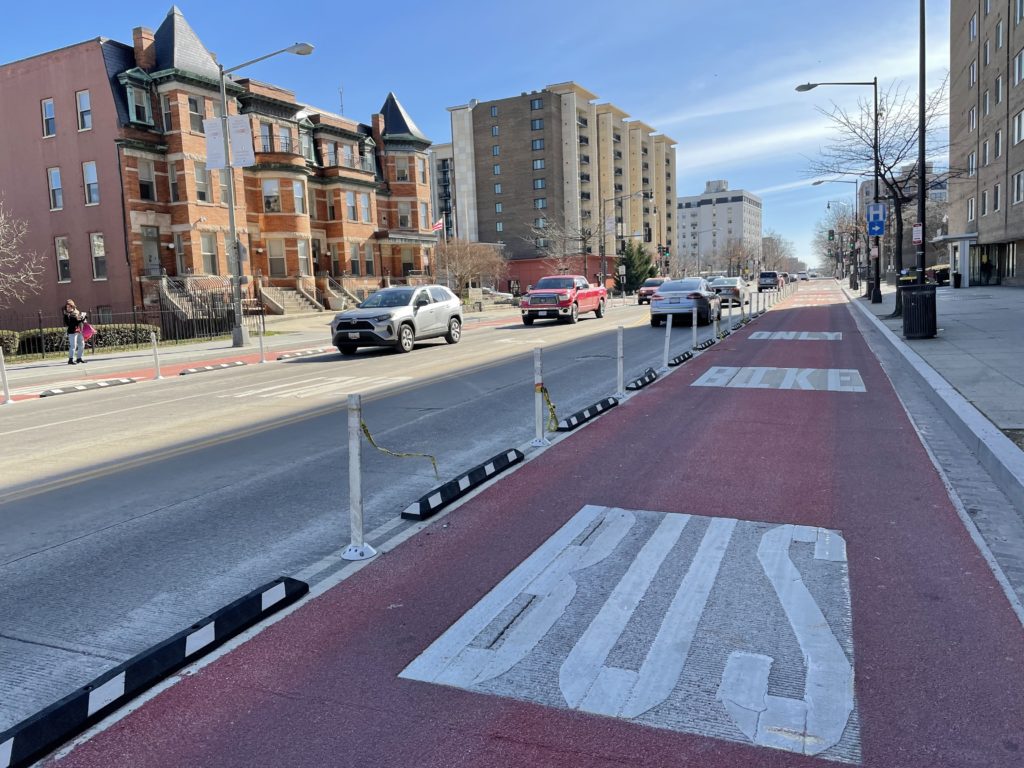

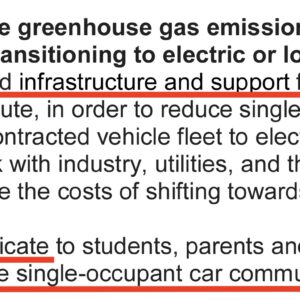
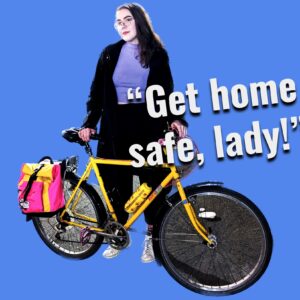
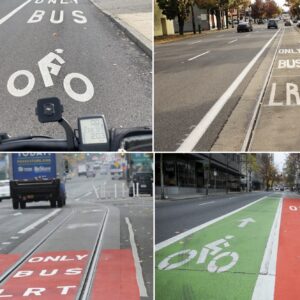

Thanks for reading.
BikePortland has served this community with independent community journalism since 2005. We rely on subscriptions from readers like you to survive. Your financial support is vital in keeping this valuable resource alive and well.
Please subscribe today to strengthen and expand our work.
Thanks for this Garrison, I agree that 82nd needs bus lanes far more than basically any other treatment outside of sidewalks. The 72 is always packed, and always slow. If we aren’t putting bus lanes onto the busiest section of the busiest bus route in the state when we spend hundreds of millions of dollars on a corridor, when will we ever manage to do so?
Exactly! Hopefully a well executed bus lane on 82nd can galvanize support for more across the city
If you wanted buses on 82nd, why would you put them on the right-hand lane where cars are constantly turning into and out of the huge number of driveways along 82nd? Anyone using the bus has to at some time cross all five traffic lanes, either going or coming back. As long as land is divided among many owners, 82nd will always have too many curb cuts.
Wouldn’t it be better for transit users to have dedicated bus lanes on the left lanes with bus stops on the median so that users would never have to cross any more than 2 lanes of traffic, one lane being rarely used except by buses? To access businesses by car drivers going in the wrong direction, the city could design u-turns every half-mile or so and prohibit left turns everywhere else.
That would definitely decrease car traffic on 82nd, because drivers could now only access half of the businesses along the corridor and would be forced to find new routes.
Or increase it if drivers make U-turns and double back to get to their destinations.
Keeping in mind, center-running busses would need to be contraflow, since our busses don’t have doors on the left hand side
No way this flies. PBOT is intentionally trying to avoid the same blowback that came from the Division redesign.
I really don’t want to wait for the bus in the middle of 82nd, and I’m not sure a redesign could make that any less sketchy.
This would be fantastic. This is the kind of design that can convince people to use the bus. If auto traffic is busy but the busses are humming along, they might actually be a preferred mode. At least on 82nd, but it’s a long road.
I wonder about the dangers of turning across the bus lane (for drivers), but maybe it’s not much of a problem. Definitely if it came with a 25mph limit, that would help.
It would be nice if bikes could be incorporated somehow, but if they shared the bus lane that would work to cancel out the benefits of the bus lane to transit riders. Unlike some, I’m ok with an alternative bike route one measly block over if that gets us a full 2 way dedicated bus lane. Worth it.
my idea is that turning vehicles would yield to busses, as they would yield for a curb adjacent bike lane. I also would love to see bike lanes added to 82nd, but its just difficult to balance all the demands various user groups have for this street
> I also would love to see bike lanes added to 82nd, but its just difficult to balance all the demands various user groups have for this street
Some unsolicited advice for a young planner: Don’t fall prey to this bureaucratic double-speak so many planners love to use.
Okay, it’s difficult to include bike lanes. But is it impossible? If it is, then just say so.
But if it’s not impossible (which it isn’t), and just merely “difficult”—and if you really would love to include them (and you should, because they take precedence over public transit on the transportation hierarchy)—then why haven’t you found a way to overcome that difficulty and include them?
I am many other Urbanists feel that buses take priority over bikes, at least on 82nd
Why?
Zach if you want to understand the esoteric priorities of Urbanism* you first need to participate in at least 10 NIMBY dogpiles, be a member in good standing of a Numtot group, pay dues to a local urbanist group, and attend “Happyhours” where you can receive secret urbanist teachings from think-tank employees.
*always spelled with a capital U (for the glory of St. Jane Jacobs and other Urbanist saints)
There’s a reason why we almost never build roads where vehicles turn right across go-straight lanes. It creates an inherent conflict.
At least with a bike lane, a driver will often know a rider is present because they just passed them before making their turn. If the go-straight lane has potentially high speed motor vehicles in it, drivers may be completely unaware they’re present. Most drivers are not in the habit of checking behind them before turning right.
The only way to make this work would be to have turning vehicles merge into the bus lane before making their turn, which would remove at least some of the advantage of having a separate lane in the first place. At times of high congestion, turning drivers will sneak into the bus lane early, slowing the buses further.
I don’t think it could work.
It’s done all over the world and this country and is the gold standard for effective transit. Turning cars need to be stopped at a signal while transit is moving through and vice versa. There’s no need to share the lane. Signals can be managed so the transit through movement is only allowed when vehicles are there.
I don’t want to put words into anyone’s mouth, but I was assuming they were talking about cars turning right into driveways mid-block as well as turning right at intersections. It seems like the signals could solve the conflict at intersections, but not driveways.
This would require a signal at every intersection and every driveway. That is a much higher signal density than I’ve ever seen anywhere.
Is that what you’re envisioning?
I think these are all great suggestions that PBOT should try to incorporate into this design. I am still frustrated to see dedicated bike infrastructure totally disregarded on 82nd, I guess anyone who drives along this stroad would have no issues following bicycles in the main travel lane going 12mph? Or is this yet another road in Portland that bikes should just be expected to stay off entirely?
Seeing a stroad in Portland get redesigned with no bike facilities really makes me feel like there’s a need for critical mass rides again.
Aaron I agree that we need more (protected) bike lanes along our arterials, the issue with 82nd is that the right of way is narrow, and unfortunately it is not likely politically feasible to take anymore space away from cars than what my redesign proposes. I think the center turn lane could be taken out, and the space freed up used for bikes, but many businesses would shout that down.
Look at latest critical fixes map. Much of the center turn lane is coming out and being replaced by concrete medians and planters. Left turns are getting a strict diet in the work currently underway. Not a future concept, actual current construction.
Yeah, that’s something I noticed was missing in this article, that there is a definite time crunch on a good deal of this money and not enough time to plan or change plans. If any of it is ARPA (covid stimulus funding), it has to be spent by Sept 30th 2026 at the latest, and there’s a real concern in DC that if a certain person gets elected president in November of this year, a lot of other infrastructure funding could suddenly end too.
I feel like someone riding their bike along this proposed update would feel really unsafe and uncomfortable riding along in the car lane where they are ostensibly meant to go in this proposal. I wonder if it will make them feel better to tell them “sorry we didn’t build you a safe place to travel through here but it was politically inconvenient so we decided to not even propose it.”
At least drivers won’t have to slow down or wait for the other cars making a left turn. I bet in 30 years we’ll all look back fondly at how keeping that left turn median improved the neighborhood character and moved us towards our vision zero, mode share, and climate goals.
I’m on board with taking out the center turn lane to make space for bikes, but that is politically infeasible, so I’m trying to be pragmatic.
I want to amend my previous comments to say that I understand why you didn’t choose to include bike lanes in your design and you’re completely right about political viability, I am just frustrated that it had to work out that way. I think this proposal is well-considered for the real world and overall I liked your guest opinion, so please take my general negativity in this thread to be frustration with the situation society is in and not to be directed at you personally.
All good, I also share the frustration
Garrison, I like your idea and your enthusiasm, but this proposal is no more politically feasible than bike lanes. If you want to find room for bikes AND buses without a corridor-long condemnation, get rid of the dedicated center turn lane and add 5.5′ wide bike lanes on each side of the street. There may be a few critical intersections when land would need to purchased for turn lanes, but a continuous center turn lane along the length of 82nd is overkill if you are only having to turn across a single lane of traffic plus the occasional bus or bike.
I keep hearing people complaining about the lack of “bike infrastructure” in the work being done on 82nd, and I feel compelled to disagree. I’ve lived 2 blocks off 82nd in the Montavilla neighborhood for 22 years and have been bike commuting daily, crossing 82nd by bike at least twice a day. I’ve also been attending the 82nd Avenue Coalition meetings regarding these improvements for 2 years now.
Each of the Rapid Rectangular Flashing Beacons (12 going in), each protected traffic island, each curb extension, each median blocking left turns with a cut-through for pedestrians and cyclists, and each pedestrian-favored signal going in directly benefits me and every other cyclist and pedestrian crossing or accessing 82nd.
Could more be done? Yes, and it should (we NEED a dedicated pedestrian crossing of I-84 proximal to 82nd). But just because we’re not getting N/S protected bike lanes on 82nd does not mean we’re not getting needed infrastructure that makes 82nd safer for cyclists.
I’m happier that it will be made less dangerous to cross this car sewer but the attitude of “at least we can get across” is not moving us away from the status quo of cars being the first and only consideration for the vast majority of our streets. Spending millions on a street rebuild in the 2020s that entrenches car dependency when we’re in the middle of a climate and road danger emergency is a failure.
I know there’s a lot of “at least we’re getting something” around here but in reality we (the whole city, not just the bike community) are making a choice to drop the ball yet again. Add this to the list of things we’ll have to work double time on later in order to catch up to where we were supposed to be by then.
What do you propose instead?
The reality is that running protected bike lanes up 82nd is a non-starter. The real estate just doesn’t exist without an hugely expensive buyout of local property, and it doesn’t even make the top-ten list of priorities for the community that actually lives there. And it would be safer and more affordable to create a N/S greenway a block two east or west of 82nd. I know not everyone feels this way, but my engagement with this community has helped me come to the realization that maybe bike lanes are not a good idea on every stroad.
We are way past the point where moves away from car dependency can be comfortable or politically popular, we’re in too deep. What’s frustrating to me is seeing everyone act like spending $185m on a project that further entrenches car dependency for decades is somehow a win because the sidewalks will be a little wider and cyclists/peds will have a few more lights where they can scurry across the car sewer.
Yeah 1000% agreed. It’s insane. Also wild how even activists and urban planners are proposing super watered down, politically safe designs. Like, they’re the ones who should be boldly challenging the status quo!
I’ll ask again.
What do you propose?
Something beyond what you don’t like about the current work.
Also, you might be surprised by how little $185 million actually buys.
And as dismissive as you are of the current work taking place, much of the work on sidewalks, medians, signals, and lighting is triage to help stop the literal bleeding taking place along 82nd. Bike lanes are going to have to take a back seat while we try to stop the dying.
This design includes both bikes and bus lanes. Easy
(Note: 56″ is the curb-to-curb width of the ROW so there would also be sidewalks on either side)
If that actually penciled out from an engineering perspective I’d support it. I’d need to see actual dimensions including sidewalk width including tree plantings and overall width fitting within the currently available footprint.
One immediate concern this presents is ability of cars to turn left into businesses. I know for many here that’s a low priority and I hear you. But trust me it was necessary for community buy in. Other than saving the lives of vulnerable road users, I would argue that the local businesses have the most at stake in the success or failure of this project.
Yeah, like Michael, that looks good if it’s real. I can show a picture of an MC Escher painting, but that doesn’t make it buildable.
Does this mean no left turns, or just left from the travel lane? Across three lanes of traffic? And you know that means cars will be swerving around the left turners into the bus lane. Maybe that’s ok, I guess. It also means cars turning right across two travel lanes, very easy to miss a cyclist. I suppose you could allow using the bus lane as a turn lane at intersections…. Maybe. Though that degrades the bus lane.
Overall this seems ok. It makes it a tolerable (but not good) bike route and a great bus route, and navigable by autos, hopefully shunting some of them over to the actual highway.
I don’t have to have a counter proposal in order to have a valid opinion about the current proposal. When you were engaging with the community did you also shut down any of their criticism by flippantly asking “well, what is your proposal then?” or did you take their concerns seriously?
If I had a gun to my head and was forced to come up with a change on the spot? I’d say completely eliminate the center lane and install a two way protected bike lane on one side. Again, I’m not a city planner so this isn’t my job and I don’t have to have a counter proposal in order to have a valid opinion about how our city is being built. Maybe convenient car travel should be what’s taking the back seat when cyclists and pedestrians are the ones getting maimed or killed by cars.
If I didn’t take your concerns seriously, I wouldn’t bother engaging with your comments.
I’m not here because this is entertaining. I’m here because it’s my home and I’m tired of seeing people die here.
In a perfect world the cars would all be shunted to I-205 and the businesses on 82nd would still thrive on the lively transit, pedestrian, and bike traffic swarming 82nd. And maybe my children will live in that world. Until then, we play the hand we’re dealt.
How about…
We put in the 8-foot sidewalks with tree wells as appropriate, have the driving lanes adjacent to the curb cuts, block all left turns except U-turns at signalized intersections, put the 2-way cycletrack in the median with another set of trees (narrowing lanes alternately for the tree wells), and run the bus lane on the left lane, but having buses swerve into the car lane to pick up/drop off passengers every half mile, like the Bee Line in Vancouver BC. The center raised protected bike lane would essentially be an express bike lane that one could only exit at certain intersections such as pedestrian islands and at signalized intersections.
Bad news, Michael, but you’re starting to sound like me: give locals a loud voice in what happens in their communities, and accept that physical, political, social, and financial reality imposes some real constraints on what we can do in the short and medium term.
I disagree. This is categorically not further entrenching car dependency, it’s the exact opposite. This is literally removing a car lane in both directions! This is exactly the uncomfortable step in the right direction we need! This is what we want. This adds a dedicated high quality (superior to cars) bus lane. Listen to yourself.
In no way does escaping car dependency mean every single road needs to have infrastructure for all modes of transportation. An alternative one block over is not just an unfortunate compromise, it’s good. 82nd is not a main street.
I guess if car lanes were removed altogether, it could work, but in that utopian future (where I hope we get), you’re going to need a lot more bus or rail traffic to make up for the cars, and it would STILL not be a nice place to ride a bike. The Greenway nearby should be improved. Maybe in said future, they should be dedicated bike highways. But putting them literally deliberately in conflict with a bus highway isn’t good idea even if you’re being idealistic.
Should we expect a similarly detailed article in the near future by someone advocating for a single combined car/freight/bus lane in each direction, much wider 20-foot sidewalks, and barrier-protected micromobility lanes and intersections?
I think I’ll write one about how we should actually just tear up the whole corridor and replace it with a 13-lane superhighway. We’ll call it 105; a necessary project to ease congestion on nearby 205.
Great write up, Garrison. One thing you didn’t mention is that bus lanes are also a great way to get higher frequency without having to hire a bunch of new drivers. When a bus runs its route quicker, it can run it more often.
True!
This article got me thinking about parallel bike routes (there isn’t continuous through street). The bus is very popular and it totally stands to reason that it should be supported. How about an elevated MAX train over 82nd. Expensive by efficient, except that there is already a parallel green line and red line along 82nd form Clackamas Center to the airport. Similar to a fictional parallel route for bikes, it is not good enough because it is not where it needs to be. Portland royally screwed up when they placed MAX lines along highways- a place difficult to get to by foot and a horrible place to be, IMO, If Portland had run the red line down 82nd, and later added the green line, 82nd and surrounding neighborhoods would be much more walkable, safer, and with more redevelopment today.
It’s crazy that the Eastern Cathay property next to the 82nd Ave Transit Center was for sale and didn’t sell. I guess they wanted $3 million for it, which is a lot, but holy crap it’s super close to transit and everything, but I guess that changed post-Covid and oh yeah…82nd.
I really thought 82nd would’ve transformed from car lots to apartments by 2024.
https://montavilla.net/2022/10/10/massive-i84-and-82nd-ave-property-for-sale/
Yeah, thinking about the car lots, I wish the city could (would) just ban those types of low value land uses. Raise their taxes through the roof maybe, ratcheting up over time. Car lots have no business being in a city. If you insist on shopping for cars in person, you can schlepp your ass a few miles out of town to a car lot. Or pay for a taxi.
https://burritojustice.com/2009/11/18/proto-bart-valencia-sky-train-to-palo-alto/
Can we me-too a bus lane for Cesar E Chavez???
Given the absurd number of curb cuts for business access along 82nd, I don’t see how a protected bus lane could be implemented like in the main article picture. The BAT lanes in Hillsdale work pretty well and keeps the buses moving.
I’d love PBOT come up with a method to encourage property owners to close driveway access along pedestrian corridors. It would make it easier to implement protected bike lanes, bus lanes, and continuous sidewalks in the future.
Agreed! I guess it might be more on the county, but some kind of tax incentive for closing excess parking lot access might do the trick. It’s absurd how many parking lots only hold a dozen cars and have 3 access driveways. Corner lots are especially bad, and encourage drivers to ‘cut through’ and skip red lights.
“but my business value proposition is so tenuous, nobody would come if they had to turn more than 90 degrees total to get here!”
A dedicated bus lane would likely end up being much like Division’s FX setup. There is now a Division St. bus stop every ten blocks or so in the city. Trimet gets rid of bus stops now to improve meeting the schedule. In future you probably won’t have to walk so far that you don’t want to take the bus if you live just two or three blocks away from 82nd. Beyond that, perhaps you need to be healthy and moderately fit..
The micro-mobility vs. bus lane discussion here is interesting because it shows our car-brain perspective of more vs mode. Micro-mobility (bike, scooter, skateboard) and transit complement each other unlike cars that only take away other transportation options. Especially on a road like 82nd, last miles micro-mobility is key to increasing transit use. Every effort should be made to include micro-mobility use, whether it is shared with transit lanes or a small carve-out. As far as political feasibility goes, the moment you take away a whole car lane- people blinded by car rage aren’t going to notice if there is a micro-mobility lane there or not.
Practically speaking, people are still going to try riding on the sidewalks or in the transit lane. It would be better to accommodate this up front and make mixed use intentional. I could see a mixed transit and micro-mobility lane with off ramps for micro mobility to yield to the occasional bus that has a driver that is trained to expect other users and travel the speed limit.
Also, TBH, it would be easier politically to squeeze in a bike lane than take away an entire lane from cars and trucks.
*mode vs mode
“Micro-mobility and transit complement each other unlike cars that only take away other transportation options. ”
Unless you use your car to get to a park and ride and take transit from there, as many people do, in which case cars and transit are complimentary.
Nice idea, but when you have that many driveways and intersections, you have to do BAT lanes. Otherwise cars and trucks would be turning across the bike lane and cutting off the bus. The BAT lanes allow right turning traffic to deal with that situation.